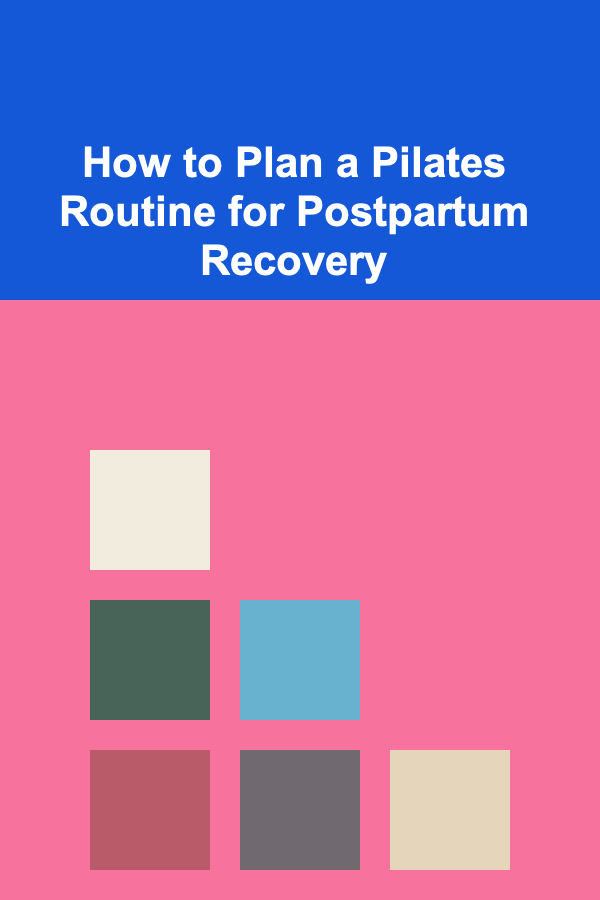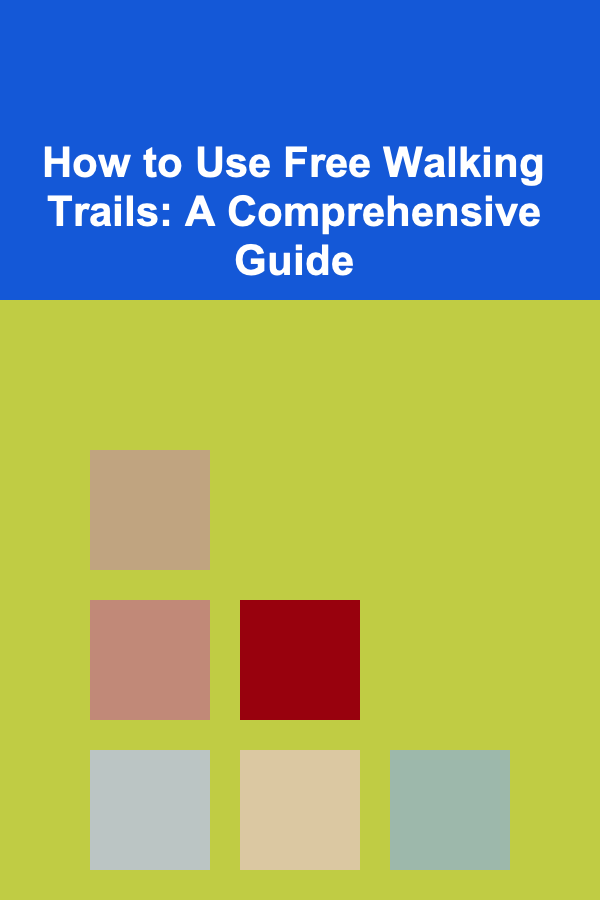
How to Plan a Pilates Routine for Postpartum Recovery
ebook include PDF & Audio bundle (Micro Guide)
$12.99$11.99
Limited Time Offer! Order within the next:

The postpartum period is a transformative time for new mothers. After childbirth, the body undergoes significant physical changes as it begins the process of recovery. For many women, staying active and strengthening their bodies during this time can help restore their physical health and mental well-being. Pilates, with its focus on core strength, flexibility, and proper alignment, is an excellent way to support the body's recovery after childbirth.
This article provides a comprehensive guide to planning a safe and effective Pilates routine for postpartum recovery. It covers the benefits of Pilates for new mothers, what to keep in mind during the recovery process, and how to develop a routine that is both gentle and effective.
Understanding Postpartum Recovery
Before diving into Pilates routines, it's essential to understand the postpartum recovery process. Every woman's recovery journey is unique, but there are common changes and considerations that most women face after giving birth.
The Physical Changes
- Pelvic Floor: During childbirth, the pelvic floor muscles experience strain. These muscles support the bladder, uterus, and rectum, so strengthening them is crucial for preventing incontinence and supporting overall pelvic health.
- Abdominal Separation (Diastasis Recti): This condition occurs when the abdominal muscles (specifically the rectus abdominis) separate during pregnancy to accommodate the growing uterus. Diastasis recti is common and can result in a weakened core that requires specific exercises to rebuild strength.
- Posture and Alignment: Pregnancy and childbirth can affect posture, with many women experiencing a forward-leaning posture, which can lead to back and neck pain. Strengthening the back and shoulders while improving posture is essential during recovery.
The Emotional Aspects
Postpartum recovery is not only about physical healing. Many new mothers experience emotional challenges, including hormonal changes, sleep deprivation, and adjusting to motherhood. Exercise, including Pilates, can help release endorphins and improve mood, making it an effective tool for emotional recovery.
When to Begin Postpartum Pilates
It's important to allow the body enough time to recover before engaging in any exercise routine. Typically, doctors recommend waiting 6-8 weeks after childbirth to start postpartum exercise, especially if the birth was uncomplicated. However, this can vary depending on the type of delivery (vaginal or cesarean) and individual health conditions. Always consult your healthcare provider before beginning any exercise program.
The Benefits of Pilates Postpartum
Pilates offers numerous benefits for postpartum recovery, including:
- Core Strengthening: Pilates emphasizes strengthening the deep abdominal muscles, which is essential for recovering from diastasis recti and improving overall core strength.
- Pelvic Floor Rehabilitation: Many Pilates exercises target the pelvic floor muscles, promoting better muscle tone and reducing the risk of incontinence.
- Postural Correction: Pilates focuses on proper alignment, helping to correct the forward-leaning posture that many new mothers develop during pregnancy.
- Flexibility and Mobility: Pilates stretches and strengthens muscles in a balanced way, improving flexibility and mobility, which can be helpful for new mothers who may feel stiff or tight after childbirth.
- Mental Well-Being: Pilates encourages mindfulness and body awareness, helping mothers reconnect with their bodies while relieving stress and improving mood.
Key Considerations for a Postpartum Pilates Routine
When designing a Pilates routine for postpartum recovery, it's important to keep the following considerations in mind:
Focus on Breathwork
Breathing is a central component of Pilates. Focusing on deep, diaphragmatic breathing helps activate the core muscles and encourages relaxation. Breathwork is particularly important in the postpartum period, as it can help to relax tight muscles and improve circulation.
Strengthen the Core Safely
After childbirth, especially if there was diastasis recti, it's important to gradually build core strength. Avoid traditional abdominal exercises (like sit-ups or crunches) initially, as they can put strain on the separated abdominal muscles. Instead, focus on exercises that engage the deeper layers of the core and avoid stressing the midline.
Gentle Progression
Start slowly and listen to your body. Postpartum recovery can take time, and it's crucial not to rush into advanced exercises. Begin with simple, low-impact movements and progress gradually as your body heals and gains strength.
Focus on Posture
As new mothers spend a lot of time holding their babies, breastfeeding, and sitting, posture becomes crucial. Pilates exercises can help realign the spine and improve posture, which is essential for preventing back and neck pain.
Incorporate Pelvic Floor Exercises
The pelvic floor requires attention postpartum. Pilates offers various exercises that help tone and strengthen these muscles, which support the bladder, uterus, and bowels. Strengthening the pelvic floor is essential to prevent incontinence and other pelvic health issues.
Avoid High-Impact or Strenuous Movements
During the early postpartum period, the body may not yet be ready for high-impact or intense movements. Focus on controlled, low-impact exercises that don't place excessive stress on the joints or tissues.
Designing a Postpartum Pilates Routine
A well-rounded Pilates routine for postpartum recovery should include exercises that focus on strengthening the core, improving posture, and rehabilitating the pelvic floor. Here's how to structure a safe and effective routine:
Warm-Up (5-10 Minutes)
Begin with gentle warm-up exercises to prepare the body for movement. This can include deep breathing, gentle stretching, and mobilizing the joints. Focus on engaging the pelvic floor and abdominal muscles from the start.
Example Warm-Up Exercises:
- Cat-Cow Stretch: On your hands and knees, alternate between arching and rounding your back to warm up the spine.
- Pelvic Tilts: Lie on your back with knees bent and feet flat on the floor. Slowly tilt your pelvis up and down, engaging the abdominal muscles.
- Breathing Exercises: Practice deep diaphragmatic breathing, focusing on expanding your ribcage and engaging your core.
Core Activation (10-15 Minutes)
Core activation exercises help rebuild strength in the deep abdominal muscles. These exercises focus on controlled movements that engage the core while protecting the lower back.
Example Core Activation Exercises:
- Pelvic Floor Breathing: Lie on your back with knees bent and feet flat. Inhale to expand your ribcage, and as you exhale, gently draw in the pelvic floor and lower abdominal muscles.
- Modified Planks: Begin on your hands and knees, keeping your back straight and engaging your core. Hold the position for 10-20 seconds and repeat.
- Single Leg Lifts: Lie on your back with knees bent. Slowly lift one leg at a time, keeping the pelvis stable and engaging the core.
Pelvic Floor Rehabilitation (5-10 Minutes)
Incorporate exercises that target the pelvic floor muscles, focusing on strengthening and relaxing them. This is especially important if you've experienced pelvic floor weakness or incontinence.
Example Pelvic Floor Exercises:
- Kegel Exercises: Contract and release the pelvic floor muscles as if trying to stop the flow of urine. Hold each contraction for 5-10 seconds, then release.
- Bridge Pose: Lie on your back with knees bent and feet flat on the floor. Lift your hips toward the ceiling, squeezing the glutes and engaging the pelvic floor as you lift.
Posture and Alignment (10-15 Minutes)
To address postpartum posture issues, focus on exercises that strengthen the back, shoulders, and neck while promoting proper alignment.
Example Posture Exercises:
- Wall Angels: Stand with your back against a wall, arms raised to 90 degrees. Slowly move your arms up and down the wall, engaging the back and shoulder muscles.
- Seated Spine Twist: Sit tall with legs crossed. Place your hands behind your head and gently twist your torso to one side, then the other, to stretch and strengthen the spine.
- Chest Opener Stretch: Sit or stand tall, interlace your fingers behind your back, and gently lift your arms to open the chest and stretch the shoulders.
Cool Down (5-10 Minutes)
Finish your Pilates routine with a cool-down phase to relax the body and reduce any tension. Focus on gentle stretching and breathing exercises to promote recovery and relaxation.
Example Cool-Down Exercises:
- Child's Pose: Sit back on your heels, stretch your arms forward, and relax your forehead on the floor.
- Seated Forward Fold: Sit with your legs extended straight in front of you. Slowly fold forward, reaching for your feet or shins, and relax the back.
Modifying Pilates for Cesarean Birth
If you had a cesarean birth, you may need to modify certain Pilates exercises in the early postpartum stages to avoid strain on the incision site. Focus on breathing, gentle movements, and core activation without putting pressure on the abdominal incision. Once your healthcare provider clears you for exercise, you can gradually incorporate more challenging movements.
Conclusion
Pilates is a highly effective and low-impact exercise that can support postpartum recovery. By focusing on core strength, pelvic floor rehabilitation, and proper alignment, Pilates helps women rebuild their strength, improve posture, and restore physical function after childbirth. The key is to start slowly, listen to your body, and progress at your own pace. Always consult your healthcare provider before starting any new exercise routine, and modify exercises as needed to suit your individual recovery needs.
Reading More From Our Other Websites
- [Organization Tip 101] How to Transition from a Traditional Office to a Home Office
- [Weaving Tip 101] Best Techniques for Incorporating 3‑D Embellishments into Flat Weave Wall Hangings
- [Home Rental Property 101] How to Conduct Regular Property Inspections
- [Organization Tip 101] How to Create a Backyard Shed Organization System
- [Organization Tip 101] How to Celebrate Jewelry Milestones with Special Displays
- [Needle Felting Tip 101] Protecting Your Hands: Choosing the Right Protective Gear for Needle Felting
- [Home Pet Care 101] How to Care for Your Pet's Coat and Fur at Home
- [Home Staging 101] How to Use Staging to Make Your Home Feel Like a Dream Vacation Destination
- [Personal Financial Planning 101] How to Prepare Financially for the Unexpected
- [Personal Care Tips 101] How to Use Toner to Prep Your Skin Before Applying Serum

Automate Your Passive Income Stream Using Deep Learning Techniques
Read More
How to Create a Portable School Supply Kit for On-the-Go Learning
Read More
How to Set Up a Pet-Friendly Holiday Decor Without the Hassle
Read More
How to Use Free Walking Trails: A Comprehensive Guide
Read More
How to Observe Raptors in Flight: A Comprehensive Guide
Read More
How to Manage Personal Loans with Variable Interest Rates
Read MoreOther Products

Automate Your Passive Income Stream Using Deep Learning Techniques
Read More
How to Create a Portable School Supply Kit for On-the-Go Learning
Read More
How to Set Up a Pet-Friendly Holiday Decor Without the Hassle
Read More
How to Use Free Walking Trails: A Comprehensive Guide
Read More
How to Observe Raptors in Flight: A Comprehensive Guide
Read More